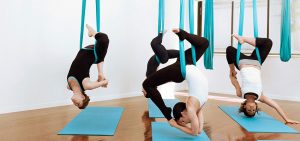Fly yoga is one way to stay fit and fight stress.
The traditional practice of asanas is good for the body and soul, while fly fitness has a number of advantages: working in a hammock relieves stress on the joints, develops pulmonary, diaphragmatic breathing, improves flexibility, and helps burn more calories. But in order for the practice of aerial exercises to bring only benefits to the body, it is necessary to do it correctly.
Fly yoga is a combined type of training that combines elements of gymnastics, Pilates and traditional yoga. Perform exercises suspended above the ground using specific equipment: hammocks, hoops, fabrics, belts, trapeziums.
Health
Body: Fly yoga for weight loss improves physical fitness. Focus on energy-intensive exercises that develop strength.
Fly yoga for beginners develops flexibility, endurance, prepares the body for complex asanas.
Spirit: the state of flight promotes meditation practices, clears the mind of stress, relieves physical tension, and promotes complete relaxation.
Thinking
Fly yoga in the daily schedule forms stable neural connections, stimulates the production of endorphins, and develops healthy thinking. Regularly practicing air asanas, you can “turn over” your mind, take a different look at things, develop non-standard thinking.
Determination
The yoga philosophy focuses on the ultimate goal. It helps to cultivate “tapas” (determination) – the vitality and energy necessary to achieve your goals.
Benefits of fly yoga
Fly yoga is suitable for both beginners and experienced athletes. Let’s highlight 5 main advantages over other sports:
Stretching of the spine. A hammock helps eliminate discomfort in the spine due to gravity, relieves stress from the vertebrae and joints. To keep the body on weight or in an inverted state, stabilizing muscles are included in the work, the muscular frame that supports the spine is strengthened.
Breath development. When performing asanas, special attention is paid to correct, controlled breathing. This develops the functional volume of the lungs and diaphragmatic breathing, increases the level of oxygen saturation in the blood, stimulates the lymphatic system.
Flexibility improvement. A flexible body gives more mobility in everyday life, develops skills to perform more complex asanas.
Antistress. Inversion poses stimulate blood flow to the head, saturate the brain with oxygen, help eliminate stress, and energize.
There is no “overtraining” effect. The advantage of fly fitness is that even with daily workouts, the body does not become enslaved. The main thing is to listen to personal feelings, internal state
Fly yoga for weight loss
If your goal is fly yoga for weight loss, then the training program should consist of energy-intensive balance exercises, complemented by a stretching complex.
Principles of correct breathing
Breathing technique is important not only for experienced practitioners, but also for beginners. Both emotional state and physical sensations depend on it. This is a powerful tool for managing psychosomatics, allowing you to reach new levels of perception.
The basics of pranayama are taught:
- Breathe with the “belly” (diaphragm): while inhaling, we leave the chest motionless, and inflate the stomach, while exhaling, we retract the stomach. This increases the amplitude of the diaphragm and the working area of the lungs (oxygen penetrates into the lower lobes).
- Breathing slowly and deeply: this allows you to accumulate positive energy and relax the body.
- Keep the rhythm: when changing asanas, it is important not to stray from even breathing. We do upward movements on inhalation, downward movements on exhalation. During static exercises, do not hold your breath.
